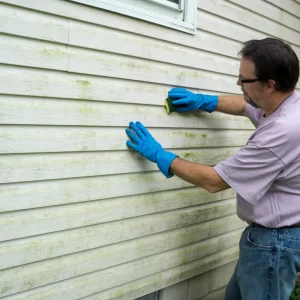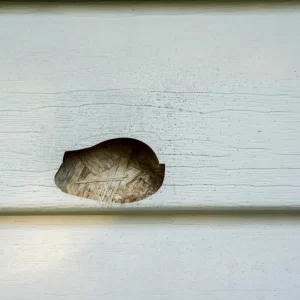
Ever wondered how to clean vinyl siding? Is there an effective means to do it without damaging the siding? Or is it too risky to handle without professional equipment? Many residential homeowners struggle with the notion that vinyl siding can only be cleaned a certain way. Others simply avoid cleaning it because they’ve had one or more bad experiences previously trying to clean it.
How To Clean Vinyl Siding By Hand

To wash vinyl siding effectively without using a pressure or power washer, you will need some type of cleaning agent that is safe for siding. Select an appropriate cleaning solution customized for this specific cleaning task. Do NOT use an all-purpose cleaner! Most big box home improvement centers (The Home Depot, Lowe’s, Menards, etc.) sell qualified vinyl siding-appropriate cleaning products. They are formulated to remove grime, dirt, and stains from exterior hard surfaces without yielding damage.
To begin, you will need a hand-held brush and elbow grease. You also will want access to a long-handled, soft-bristled (or soft microfiber) scrub brush (to reach higher or more difficult-to-reach locations) and many soft-sided rags. At all costs, avoid any harsh or abrasive cleaning tools. They will damage the vinyl siding. You will need at least a couple of buckets to mix the cleaning solvent and use for rinse water. Finally, you will need to access a ladder for harder-to-access locations.
For best results, begin at the top of the house and work your way down. Rinse the cleaning solvent thoroughly so that no residue remains. You will likely work more efficiently with access to a steady stream of water (such as a garden hose). If you elect to spray the vinyl siding with a garden hose, use a nozzle or sprayer that doesn’t apply high pressure against the siding. Ideally, you should manually clean the vinyl siding at least once annually. Avoid waiting more than a couple of years.
Using A Pressure Washer To Clean Vinyl Siding
 If you don’t own a pressure (or power) washer, you can usually rent one from most home improvement centers or hardware stores. Add the cleaning agent and dilute it as directed by mixing in water. Use the detergent nozzle setting to apply the cleaning solution. Stay at least 3 feet from the siding to avoid applying too much pressure against the home. Always begin with the lowest pressure setting on the power washer, which is usually between 1,300 and 1,600 PSI.
If you don’t own a pressure (or power) washer, you can usually rent one from most home improvement centers or hardware stores. Add the cleaning agent and dilute it as directed by mixing in water. Use the detergent nozzle setting to apply the cleaning solution. Stay at least 3 feet from the siding to avoid applying too much pressure against the home. Always begin with the lowest pressure setting on the power washer, which is usually between 1,300 and 1,600 PSI.
Once you spray the home’s siding with the cleaning solvent, wait about 5 to 10 minutes for it to break down the grime and dirt. To rinse the solution off the home with water, use a 25-degree (green tip) or 40-degree (white tip) angle. Do not apply water directly to the siding with a non-angled or low-angled (less than 25-degree) setting. These settings will damage the siding.
5 Ways To Avoid Damaging Vinyl Siding When Cleaning It
1. Avoid Using Abrasive Cleaning Tools
Paint scrapers, wire brushes, and steel wool are popular with homeowners for cleaning various areas of their homes. Don’t use them against vinyl siding. They will scratch, puncture, and discolor the siding.
2. Bypass Power Washing At An Angle If Possible
If you clean your siding with a power washer, keep it at eye level. If possible, avoid spraying up or down. Spraying at an angle may not yield the desired results, and water may slip behind the siding, resulting in moisture damage.
3. Don’t Use A Power Washer Or Hose Sprayer On A High Setting
Unfortunately, applying too much pressure against vinyl siding will cause irreversible damage. Although vinyl siding is durable, excess sustained pressure may result in denting, stripping, buckling, or puncturing.
4. Stay Away From All-Purpose Cleaning Solutions
Although all-purpose cleaners may appear safe for use on vinyl siding, some may contain chemicals that can damage the siding. Avoid compromising your vinyl siding’s integrity when safe products are readily available.
5. Steer Clear Of Applying Harsh Chemicals
Many homeowners will use anything to clean their homes: liquid grease remover, furniture polish, concentrated chlorine bleach, and organic solvents. Avoid them. They may cause irreversible damage to the siding.
Identifying Siding Damage While Cleaning It Safely
 Evaluating your siding’s condition is best performed during and after cleaning. Take observations and note areas of concern. Clean vinyl siding can reveal flaws, imperfections, and damage requiring addressing. It also may demonstrate the need for replacement. For example, most siding professionals recommend replacement if the siding has many pockmarks from hailstones.
Evaluating your siding’s condition is best performed during and after cleaning. Take observations and note areas of concern. Clean vinyl siding can reveal flaws, imperfections, and damage requiring addressing. It also may demonstrate the need for replacement. For example, most siding professionals recommend replacement if the siding has many pockmarks from hailstones.
Hiring A Knowledgeable Siding Replacement Specialist
If you own a home in or around Greater Charleston, choose the siding installation professional that more homeowners trust. At TriCo Exteriors, we pride ourselves on delivering efficient yet exceptional results. We understand the delicate intricacies of installing siding correctly. No matter your siding preference, we have the tools and knowledge to assist you expertly. Contact us today to learn more about our siding services or to schedule an appointment (and receive a free estimate).




